When something in your collection is damaged, we know that your first reaction may be tears. That’s okay. Let’s take a moment of silence together to mourn.
Once you properly grieve, we want to help you manage and account for the damages within RW Elephant.
There are two parts to dealing with damages within your rental business.
1. Managing Damaged Items & their availability.
2. Damage Fees. (Who pays for this party foul?)
With RW Elephant’s Damaged & Missing Item Workflow, you can manage both of these in one simple process.
MANAGING DAMAGED ITEMS & THEIR AVAILABILITY
Start by determining if the Item is damaged beyond repair, missing, or if it can be fixed and returned to your collection.
Items That Can Be Repaired:
Head to the original Order where the Item was damaged.
From the “Line Items tab,” select the Item that you need to repair and right-click on it.
Select “Damaged or Missing…”

This will open a Damaged/Missing Item pop-up window to manage the damage.
For Item Condition, you’ll select “Damaged – Repairable.”
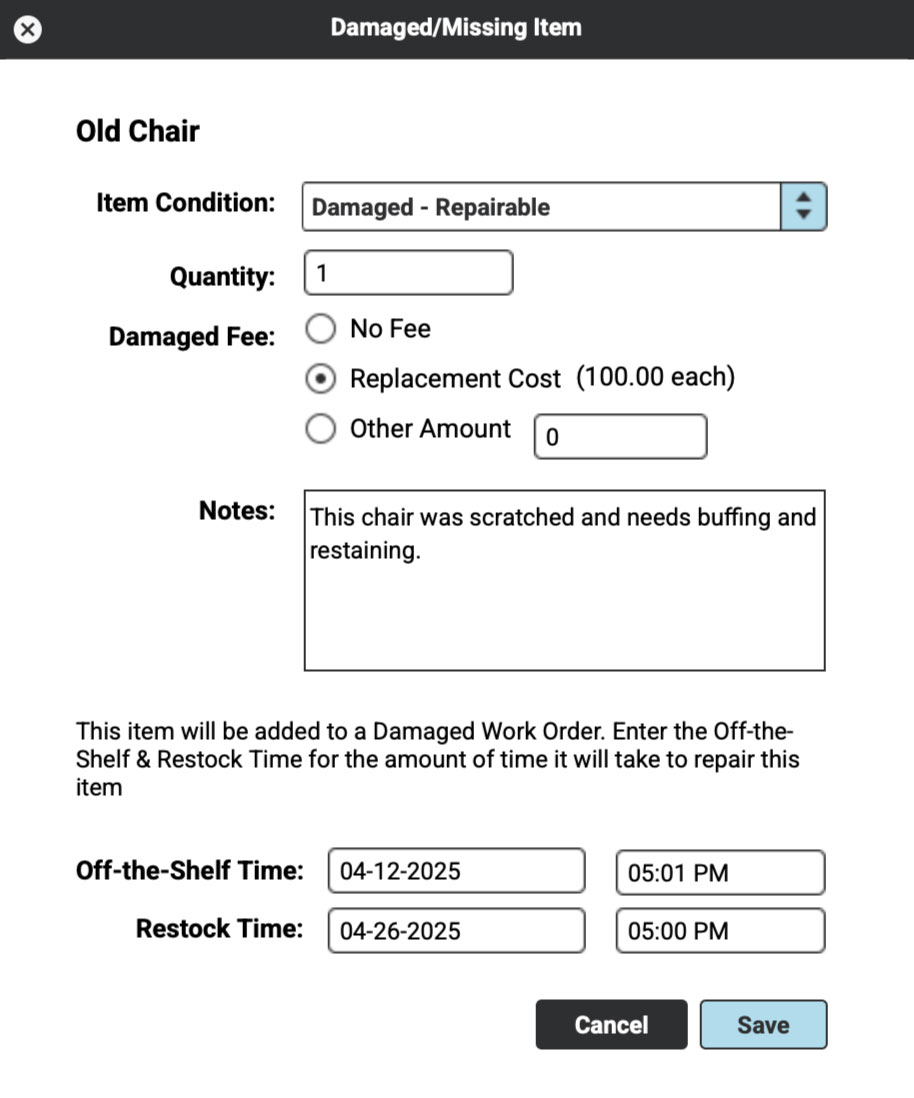
Enter the Quantity of the Item that needs repairs.
Now decide if you’ll pass along a fee to your customer or not. You have three choices:
- No fee
- The Replacement Cost of the Item (if you’ve entered one)
- Manually enter an amount
Not sure what to charge? We’ll talk more about your Damage Fee options below.
In the Notes field, enter any notes you want to appear on the Damaged Work Order about the Item. Be specific so your crew knows exactly what needs repairing.
Lastly, RW is going to create a new Damaged Work Order to pull this Item out of Inventory while it is being repaired.
Enter the Off-the-Shelf and Restock Time of the new Damaged Work Order. This is the amount of time it will take for the Item to be repaired. RW will suggest the Off-the-Shelf Time as one minute after it returns from the original Order, and the Restock Time as two weeks later. Change this window to how long it will realistically take to repair the Item.
Click the blue “Save” button.
RW will give you one of two pop-ups. You’ll either see that the Item was successfully added to a Damaged Order or that there is a conflict with the Item.
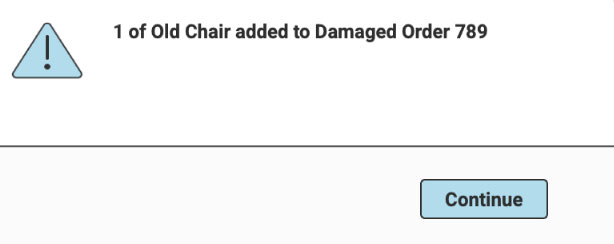
OR
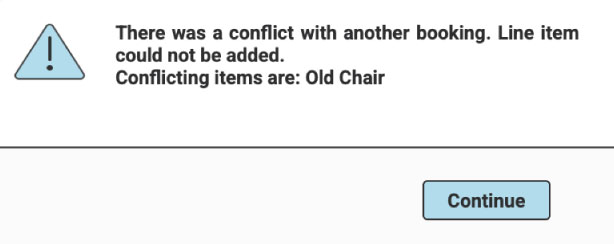
If you received a conflict, head to the Item Usage Quick Display of the Order to see where the conflict is.
If the piece is on an Order before the Item will be repaired, you have two options:
1. Remove the Item from that future Order & notify the customer.
OR
2. Change the Restock time of the Damage Order to a sooner date and push your repairs to be done faster.
When the Item is fixed and ready to rent, change the Restock Time of the Damaged Order to the current time so it is available to rent immediately.
Items Damaged Beyond Repair or Missing:
If you’ve found a home for the Item and can sell it in its damaged condition, create a Sale Order to remove the Item from your Inventory and record the profit.
However, if you simply need to remove it from your Inventory, head to the original Order it was damaged on or went missing from.
From the “Line Items” tab, select the Item that is damaged beyond repair or missing and right-click on it.
Select “Damaged or Missing…”

This will open a Damaged/Missing Item pop-up window to manage the damage.
For Item Condition, select either “Damaged – Beyond Repair” or “Missing” from the drop-down menu.
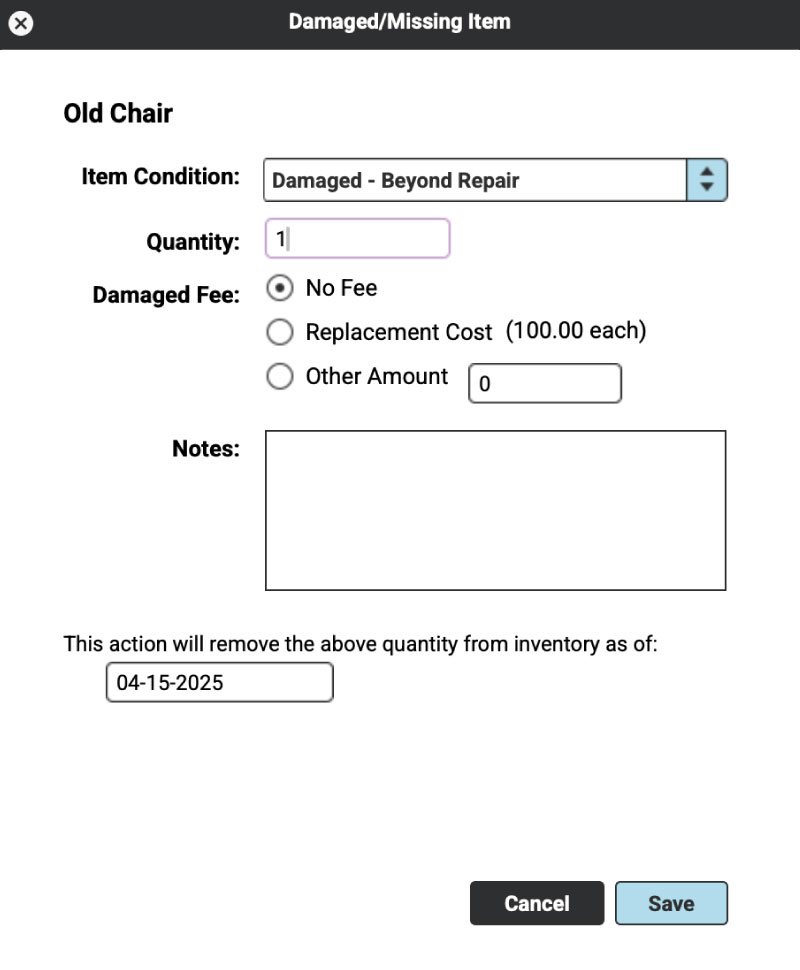
Enter the Quantity of the Item that is damaged beyond repair or missing.
Now decide if you’ll pass along a fee to your customer or not. You have three choices:
- No fee
- The Replacement Cost of the Item (if you’ve entered one)
- Manually enter an amount
Not sure what to charge? We’ll talk more about your Damage Fee options below.
In the Note section, enter any notes that you want to appear with the negative Quantity Change Event that RW will create for this Item.
Enter the date that you want to remove the Item from your Inventory through the negative Quantity Change Event. RW will suggest one day after the Restock Time of the original Order the Item came off of.
Click the blue “Save” button.
If the Item is on future Orders, remove it from those Orders and notify your customers.
You’ll be able to see the negative Quantity Change Event within the Item itself under the “Quantity Change Events” tab.
DAMAGE FEES (Who pays for this party foul?)
The first place to start with Damage Fees is to decide how you are going to handle the cost of damages.
Check out our blog post about Dealing with Damages in your Event Rental Business and the different ways of covering damage costs.
Here are the 4 common ways of handling damages:
- Eat them as a cost of doing business (perhaps raising your prices to account for this).
- Charge a Damage Waiver fee, aka Equipment Protection Fee, up front (usually 10-13% of the rental total) and then “forgive” damages that occur at the event.
- Collect a security deposit before the event that is only returned in part or in full, depending on the damages that occur.
- Charge your customer to repair or replace damaged or missing Items after the event.
AT THE EVENT
At any point in the delivery process, your crew can mark Items as Damaged or Missing through the RW Elephant iOS App.
As the delivery crew checks off Items through Delivery Checklists, they can also swipe left on an Item to report it either Damaged or Missing.
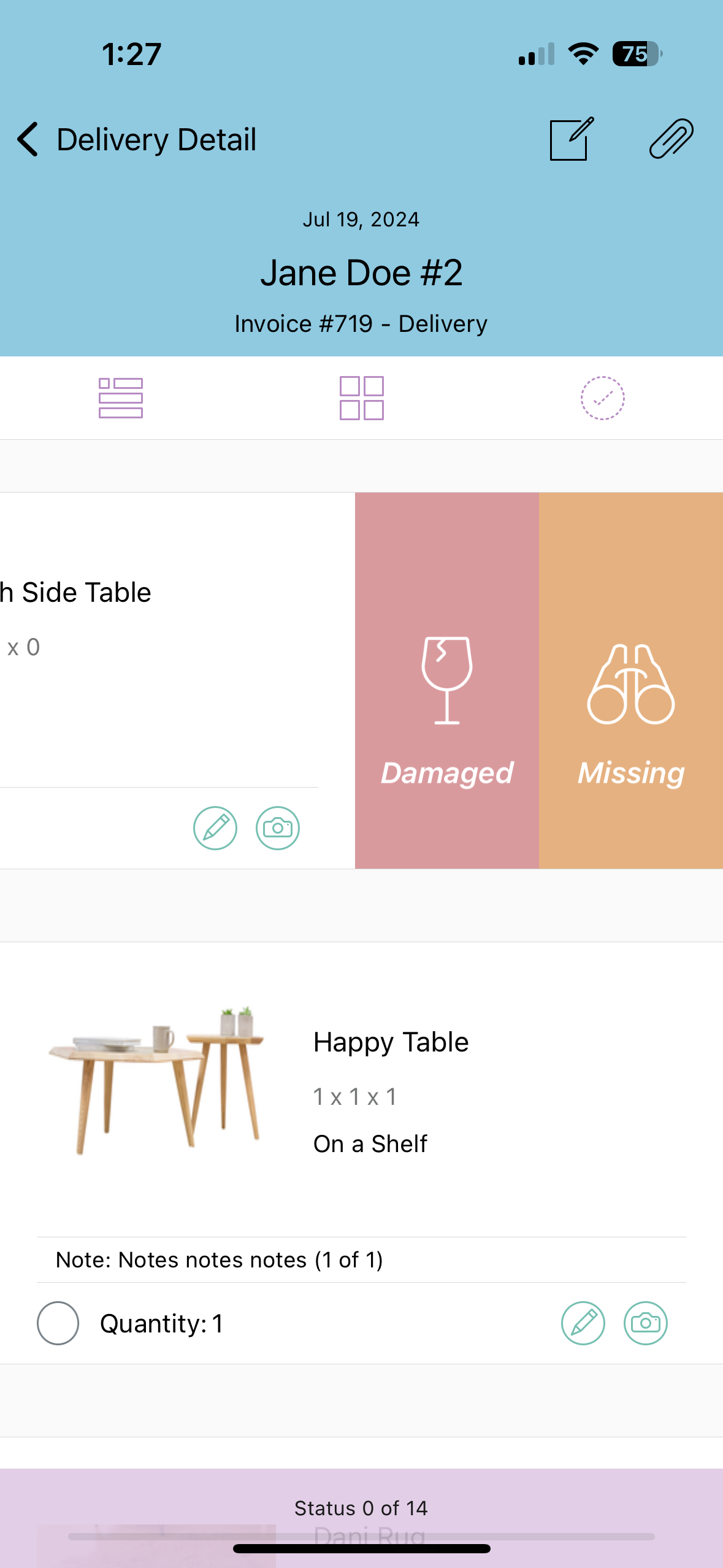
Here they can report how many were damaged, enter any notes about the condition, and take pictures of the damage directly within the app while still onsite.

They can show the reported Items to the customer to acknowledge when signing off on the Return Checklist.
Once the Checklist is completed, an email will be sent to your office staff (see Damage Alerts Email) letting them know that there are Items that need managing. They’ll follow the steps within Pending Items to either move the Item to a Damaged Order or remove it from Inventory.
If your team doesn’t use the RW iOS App, you’ll want to use the custom text box at the bottom of the Delivery Ticket to provide your crew with a place to list Damages at the end of an event upon pickup. Make sure they have an Onsite Contact sign acknowledging the Damages before things get repacked on the truck.
You’ll also want to have an inspection process in place so that Items are looked over in the light of day once they are back in your warehouse.
Once you’ve determined which Items need to be cleaned, repaired, or replaced, assess which costs you’ll be passing on to your customer.
CHARGE YOUR CUSTOMER AFTER THE EVENT
If you follow one of the above processes (Damaged Repairable or Beyond Repair) and do decide to pass along a fee to your customers, RW will automatically add a “DAMAGED/MISSING ITEM FEE” Line Item to the original Invoice.
Depending on your Terms & Conditions, you may be able to just run the card you have on file (although we suggest you always communicate with your customer first before running a damage charge!). Particularly if you use RW Pay (or Stripe) through RW Elephant, you won’t even have to enter the credit card info again.
Now that you have had time to grieve and (hopefully) move on, let’s talk about selling Items.